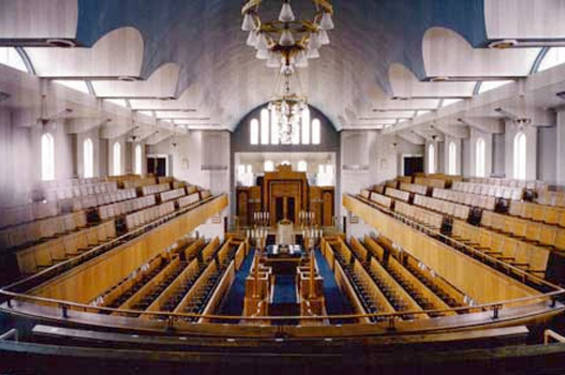This website uses cookies
This website uses cookies to enable it to function properly and to analyse how the website is used. Please click 'Close' to accept and continue using the website.



The Twentieth Century Society was delighted to learn on the 6th February 2008, that the New Hebrew Congregation Synagogue in Liverpool’s Greenbank Drive has been upgraded by the Department of Media, Culture and Sport on the initiative of the Twentieth Society to Grade II*. The Society had applied for the upgrade following unsympathetic proposals to convert the building into a series of self-contained flats – which would have destroyed the outstanding, unique interior.
Greenbank Drive Synagogue was constructed in 1936/7 and was consecrated on 15th August 1937. It was designed by an architect whose work was synonymous with Merseyside, Ernest Alfred Shennan. In this daring, innovative design he abandoned the art deco style he usually favoured, and drew on Swedish Functionalism to create a thoroughly modern building. It is one of the most architecturally important synagogues in the country. It also has immense socio-historic significance, representing a last, late optimistic cultural expression of European Jewry before the Holocaust.
The Twentieth Century Society is very pleased that English Heritage, after a thorough assessment, has upgraded the building to Grade II*. With over 90% of the UK’s listed buildings listed at grade II, an upgrade of this kind is rare and demonstrates the exceptional qualities of the synagogue.
The buildings future however, is still uncertain. The current development proposals will now have to be reconsidered and a wholly different approach taken to the building to ensure its unique interior remains intact. The Twentieth Century Society will continue to fight for a sympathetic scheme for re-use that is to the benefit of the building, the owners and the wider community.
Ends
1. Although there are a number of architecturally impressive synagogues dating from the late 1920’s and 1930’s, they are all too some degree exercises in historicism, often combined with exoticism. (See for example the splendid Byzantine Art Deco of the former Leeds New Synagogue, now the Northern School of Contemporary Dance, 1938 by J Stanley Wright and Clay.)
2. Prof. Carol Krinsky refers to Greenbank Drive Synagogue as exemplifying the “contemporary tendency towards simplicity and clarity”, in the interwar period. (See Professor Carol Herselle Krinsky’s Dover Publishing, USA, Page 94.
3. Listed Buildings are graded to show their relative architectural or historic interest:
4. The architect was Sir. Ernest Alfred Shennan. Most of his surviving work is in the Merseyside area and comprises a wide diversity of buildings. His pre-war work included Westminster Banks (at Dingle 1931 and Crosby 1931 in Liverpool; Birkenhead 1932 and West Kirby 1931in Cheshire); Cinemas (The Carlton 1932, Plaza 1933, Mayfair 1938 and the now listed deco Forum Cinema (now the ABC)) on Lime Street, Liverpool L1; restaurant interiors (The French Café and Arabic Café, both 1933, Liverpool); Dance Halls (The Grafton Rooms Liverpool 1934); and various art deco hotels and office blocks.
Shennan established a leading architectural practise in the North West, with offices in North John Street, Liverpool. After the war, his firm, which in 1952 had a staff of 23, produced a number of HQ office buildings, including Spinney House for Littlewoods (1959) and Pearl Assurance House (1959) together with a range of industrial and other buildings, almost all on Merseyside. His practice produced one church, the RC Church of Our Lady of Assumption in Liverpool (1950). He became the Conservative Leader of Liverpool City Council and was the Chairman of its Post War Redevelopment Committee. He was later knighted for services to local government
For more information and images please contact:
Jon Wright, Caseworker – The Twentieth Century Society,
Tel 020 7250 3857 or e-mail jon.wright(at)c20society.org.uk

Become a C20 member today and help save our modern design heritage.